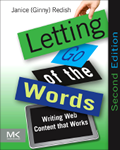 A review of
A review of
Letting Go of the Words: Writing Web Content that Works (2nd edition)
by Janice (Ginny) Redish
Morgan Kauffman
Do you write for the web? Evaluate websites? Read on the web? Then you need this book.
I was impressed with the first edition of this book in 2007, and I am even more impressed with this rewrite. Not only did Ginny Redish keep all my favorite sections, she made them better by using her own advice in the book. She also added information and managed not to increase the page count…a truly remarkable achievement.
This edition includes more on content management and makes clear the relationship between that discipline and user-centered design, where so many of us in the UX field spend our days. I don’t know about other readers of this magazine, but I spend more of my time on content management now than previously in my UX career.
For those who learn best from stories (and who among us doesn’t?), Redish has added case studies and interludes throughout the book, which offer great insight if you only have time to scan the book quickly. They are also wonderful as a quick refresher. For example, one case study discusses how a very successful website anticipates the site visitor’s questions; another describes how product pages on an e-commerce site hold conversations with little to no text.
Plain Language
Having trained as a linguist, with a Ph.D. in Linguistics from Harvard, Redish has been one of the central figures in the plain language movement since well before the publication of the first edition of this book. In a logical move, both editions include advice on how to write more clearly. Depending on our audiences, we may have people who read poorly, those who are in a hurry, those for whom English is a second language (or third or fourth…), or those who scan. In all these cases, plain language can make the difference between a successful visit to your site and a bounce.
Below is the same paragraph as above, tuned-up using some of the tips provided in Chapter 10 “Tuning up Your Sentences”:
Ginny Redish trained as a linguist and has been a central figure in the plain language movement from the first. In a logical move, both editions of this book include advice on how to write clearly. After all, your website visitors may read poorly, scan pages in a hurry, or have another language as their native tongue. In all these cases, clear writing can keep your visitors fulfilled and on your site.
In the same spirit, be sure to read “Interlude 4: Legal Information Can Be Clear”. It’s a great example of how to work with the lawyers in your (or your client’s) company to ensure success for everyone. There is even a model of a well-written privacy policy.
Conversation
Redish has included information on how to ensure that your web pages conduct helpful conversations with your site visitors. Recent research on trust and use of the web demonstrates that people respond better when their interactions feel like a relationship with another person. In fact, forms research has shown that if a form asks a question too soon in the relationship, people will not respond to that question. Or you might lose them altogether. As Redish points out, you should be applying the same rules of relationship and conversation to all web writing.
You Need This Book
Redish is one of the senior UX practitioners who helped shape the user experience field. In 1995, she set up one of the first independent usability labs in North America. We have benefited for years from her experience, her keen eye, and her willingness to share. Those working in content management have become great fans of Redish’s work, but as this book illustrates so well, she hasn’t left us behind. Redish continues to push the frontiers of user experience research, bringing awareness to new groups. She continues to stress the importance of making the world better for those who use the web, especially those who use it under adverse conditions (those using a handheld device, having mediocre or poor internet access, or those with accessibility issues like vision, mobility, or cognitive problems). In case you missed it, all of these include an increasing portion of the world’s population.
Let’s let go of the words. We need this book.
